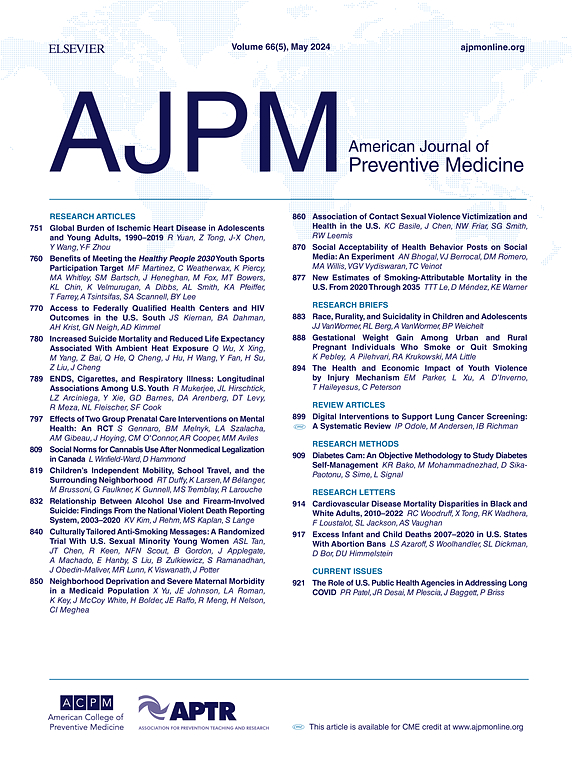State Earned Income Tax Credit and Food Security: Results Among Economically At-Risk Households With Children
IF 4.3
2区 医学
Q1 MEDICINE, GENERAL & INTERNAL
引用次数: 0
Abstract
Introduction
The Earned Income Tax Credit is a key program to reducing U.S. child poverty. Approximately half of U.S. states have augmented the federal Earned Income Tax Credit, leading to wide variation in state Earned Income Tax Credit access and generosity. Yet, questions remain around the effectiveness of state tax credits in improving basic child needs, such as food security, and whether the policy can equitably narrow longstanding disparities. The purpose of this study was to evaluate the effects of the state Earned Income Tax Credit on food insecurity among economically at-risk U.S. households with children and explore differential effects across sociodemographic groups.
Methods
The authors used an intent-to-treat causal inference design and household-level data from all 50 U.S. states available from the Current Population Survey. The authors estimated the effect of state variation in Earned Income Tax Credit generosity on food insecurity from 2001 to 2022 among a sample of 153,683 households with children and limited parent educational attainment. Analyses were performed in 2024.
Results
Compared with households living in states without a refundable state Earned Income Tax Credit, those living in states with the most generous refundable tax credits experienced significant declines in food insecurity (0.25 percentage point reduction [95% CI= −0.42, −0.09]). In addition, beneficial reductions in food insecurity were observed to be larger for single-headed than for partnered households and for non-Hispanic Black than for non-Hispanic White households.
Conclusions
Findings indicate that state legislatures that elected to implement a more generous refundable state Earned Income Tax Credit have also improved childhood food security among households at high risk for economic hardship.
国家劳动所得税抵免和食品安全:有孩子的经济风险家庭的结果
劳动所得税抵免是减少美国儿童贫困的一个关键项目。美国大约一半的州已经扩大了联邦劳动所得税抵免,导致各州劳动所得税抵免的获取和慷慨程度存在很大差异。然而,关于国家税收抵免在改善儿童基本需求(如食品安全)方面的有效性,以及该政策是否能够公平地缩小长期存在的差距,问题仍然存在。本研究的目的是评估国家劳动所得税抵免对有孩子的经济风险美国家庭食品不安全的影响,并探索不同社会人口群体的差异影响。方法:作者使用意向处理因果推理设计和来自美国所有50个州的家庭数据,这些数据来自当前人口调查。作者在153,683个有孩子且父母受教育程度有限的家庭样本中,估计了2001年至2022年各州在劳动所得税抵免慷慨程度方面的差异对食品不安全的影响。分析于2024年进行。结果与没有可退还的州所得税抵免的家庭相比,那些生活在可退还税收抵免最慷慨的州的家庭的粮食不安全状况显著下降(减少0.25个百分点[95% CI= - 0.42, - 0.09])。此外,在粮食不安全方面,单户主家庭的有益减少幅度大于伴侣家庭,非西班牙裔黑人家庭的有益减少幅度大于非西班牙裔白人家庭。研究结果表明,选择实施更慷慨的可退还州所得税抵免的州立法机构也改善了经济困难高风险家庭的儿童食品安全。
本文章由计算机程序翻译,如有差异,请以英文原文为准。
求助全文
约1分钟内获得全文
求助全文
来源期刊

American Journal of Preventive Medicine
医学-公共卫生、环境卫生与职业卫生
CiteScore
8.60
自引率
1.80%
发文量
395
审稿时长
32 days
期刊介绍:
The American Journal of Preventive Medicine is the official journal of the American College of Preventive Medicine and the Association for Prevention Teaching and Research. It publishes articles in the areas of prevention research, teaching, practice and policy. Original research is published on interventions aimed at the prevention of chronic and acute disease and the promotion of individual and community health.
Of particular emphasis are papers that address the primary and secondary prevention of important clinical, behavioral and public health issues such as injury and violence, infectious disease, women''s health, smoking, sedentary behaviors and physical activity, nutrition, diabetes, obesity, and substance use disorders. Papers also address educational initiatives aimed at improving the ability of health professionals to provide effective clinical prevention and public health services. Papers on health services research pertinent to prevention and public health are also published. The journal also publishes official policy statements from the two co-sponsoring organizations, review articles, media reviews, and editorials. Finally, the journal periodically publishes supplements and special theme issues devoted to areas of current interest to the prevention community.
 求助内容:
求助内容: 应助结果提醒方式:
应助结果提醒方式:


